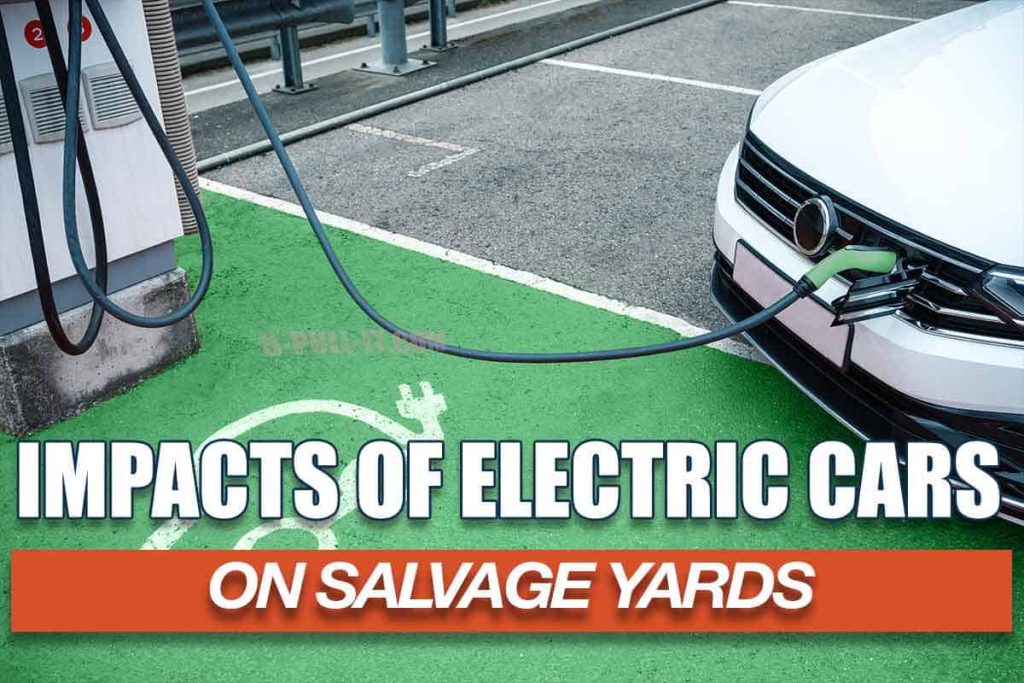Ever wondered how the surge in electric vehicles (EVs) is shaking things up in the automotive industry? It’s not just about Tesla or other automakers’ models zipping by on the highway. This shift from traditional ICE vehicles to EVs, driven by auto companies, has implications that reach far and wide, even into unexpected corners like salvage yards dealing with acid batteries.
Ice vehicles are losing ground fast, with industry experts predicting a significant rise in the EV market. Why? Well, EVs pack a powerful punch for the environment, slashing emissions left and right. But what’s happening inside those old-school salvage yards as more and more traditional cars are replaced by hybrids and EVs from automakers? Auto companies are certainly feeling the shift. Stay tuned as we delve into this lesser-explored aspect of the electric vehicle revolution.
Understanding the Impact of Electric Cars on Salvage Yards
The Decline of ICE Vehicles
Automakers’ salvage yards, once brimming with traditional cars powered by internal combustion engines (ICE), are witnessing a decline. As auto companies in the automotive industry gain popularity with their electric vehicles (EVs), fewer ICE vehicles find their way to these yards.
Rise in EV Parts and Batteries
On the flip side, there’s an increase in electric vehicle and hybrid vehicles parts, including batteries for recycling. Salvage yards are now home to discarded ice vehicles as automakers shift focus.
- Lithium-ion batteries
- Electric motors
- Power Electronics
- Charging equipment
Operational Changes in Salvage Yards
The influx of electric vehicles (EVs) is changing salvage yard operations, impacting ice vehicles and hybrid vehicles. Here’s how automakers are responding.
- New tools and techniques for dismantling EVs.
- Training staff on handling high-voltage systems.
- Adapting storage solutions for bulky batteries.
Safety Concerns with EVs
Handling and dismantling EVs brings new safety concerns:
- Potential electrical shocks from improperly disconnected batteries.
- Risk of thermal runaway – a chain reaction leading to battery packs fire.
- Toxic fumes from damaged or burning batteries.
So, what’s the takeaway? The rise of hybrid vehicles and electric cars like Tesla is shaking up salvage yards big time! With fewer ICE cars and more EV battery packs to deal with, alongside a booming EV market, it’s a whole new ball game out there!

Auto Recyclers and Salvage Yards: The Changes
Specialized Training for EV Components
Auto recyclers like salvage companies are having to gear up. Electric cars, such as Tesla, are not like traditional cars. They need specialized training to handle components like EV battery packs of these new-age vehicles. It’s not just about pulling out a part and fixing it in another car anymore, the market is changing.
Recycling High-Value Materials
The market for the recycling industry is seeing a shift. More focus is now on high-value materials from electric vehicles (EVs). Automakers and auto companies are all in the game, eyeing precious metals like cobalt and lithium found in EV batteries.
Example: Cox Automotive, a big player in the market, has already started its journey towards this new trend.
The cost of manufacturing new technology to dismantle and sort the materials that make up electric vehicles, including ion batteries, is something that needs to standardize. This is crucial as most EV manufacturers are using different kinds of materials and components, affecting the market and residual value. This diversity makes it challenging for salvage yards to recycle these vehicles efficiently and cost-effectively, especially when compared to traditional internal combustion engine (ICE) vehicles.
Residual Value of EVs
The residual value is the worth of a vehicle after it’s used, like an electric car that’s no longer drivable. This is crucial in the EV battery and ICE market, where these cars often end up in salvage yards. They’re not merely junk; they house valuable parts like batteries, motors, and sensors that can be reused or sold.
These parts, including ion batteries, make up the car’s residual value. As more electric cars equipped with ion batteries are made, the market for these parts grows. So, it’s important for salvage yards to understand this value to make more money and help the environment. Residual value also applies to the car’s software and patents, which tech companies can use.
Electric cars and hybrid cars, equipped with ion batteries, are revolutionizing the market dynamics at salvage yards. This is due to their ‘residual value’, meaning the worth of their parts including ion batteries. By understanding this, salvage yards can stay profitable and contribute to the environment. When these eco-friendly cars stop working, they make their way to the market of salvage yards.
Dismantling cars, particularly those with complex parts like big batteries, can be costly due to the need for special tools and trained personnel. This is especially true for hybrid cars, which use both gas and electricity, thus increasing their residual value. Despite the cost and high residual value, it’s crucial to dismantle these vehicles to recycle materials and protect the environment. So, dismantling these cars can be costly but important.
Tech-Savvy Salvage Operations
Salvage yards aren’t just heaps of metal anymore. Technology is making its way here too. From drones scanning for specific parts to AI-powered systems sorting materials, salvage operations have taken a leap into the future.
Adaptation Strategies by Auto Recyclers
Change is inevitable. And those who adapt to innovations like ion batteries survive. The automotive industry understands this well.
- Repair shops are learning new skills.
- Manufacturers are partnering with recyclers.
- Insurers are adjusting their policies around EV ownership life.
Case Study: A local salvage company recently partnered with an auto manufacturer to ensure the efficient recycling of EV components.
In short, electric cars have brought about significant changes that affect everyone involved – consumers, repair shops, manufacturers, and insurers – everyone’s adapting to the new normal in one way or another.
Challenges in Electric Vehicle Battery Recycling
Separating Valuable Materials
Recycling EV batteries ain’t a walk in the park. The big challenge? Splitting valuable materials from used batteries. It’s like trying to find a needle in a haystack, only harder.
- Lithium
- Other metals
These goodies are trapped inside EV battery packs. Getting them out is tough and time-consuming.
Safety Risks
Next up, safety risks. Ever tried juggling knives? That’s what handling used EV batteries feels like. There’s danger at every turn:
- Fire hazards
- Chemical leaks
- Toxic fumes
These risks make the recycling process as tricky as a tightrope walk.
High Costs of Recycling Tech
Let’s talk money now: recycling tech costs an arm and a leg.
- Advanced Machinery
- Specialized facilities
These things don’t come cheap! And it’s not just about buying them – running and maintaining these beasts is another story altogether.
Regulatory Challenges
Last but not least: red tape. Regulations for battery waste management are as clear as mud, with different rules in different places. This makes navigating the legal landscape feel like going through a maze blindfolded.
So there you have it, folks! The impact of electric cars on salvage yards is real and complex, filled with challenges at every step of the way.
Potential Solutions for Battery Recycling
Ever thought about what happens to old car batteries? They don’t just disappear into thin air. Let’s talk battery recycling.
Efficient Recycling Processes
Battery makers are working their socks off to develop efficient, cost-effective recycling processes. Think of it as giving batteries a new lease on life. It’s all about battery health and making sure we get the most out of them.
Second-Life Applications
But before we send our battery packs to the big recycling plant in the sky, there might be some juice left in them. We’re seeing a rise in second-life applications for used batteries. So instead of tossing your structural battery pack, it might find a new home powering something else.
Government Incentives
Governments aren’t just sitting on their hands either. They’re stepping up with incentives and regulations promoting battery recycling. It’s not just about saving bucks; it’s also about saving the planet.
Research and New Technologies
Researchers are burning the midnight oil looking into new technologies for safe, effective battery disassembly. Acid batteries, ion batteries – you name it, they’re on it.
So next time you’re marveling at your electric car’s battery range or its energy storage capabilities, spare a thought for where it’ll end up. With advances in technology and forward-thinking legislation, that old battery could have quite an exciting future ahead!
The Technology Role in Junk Car Recycling Industry
Robotics and Automation
Technology is a game-changer in the salvage yard business. Think about robotics and automation. They’re transforming the dismantling process, making it faster and more efficient.
- Robots can pull apart cars piece by piece, sorting materials for recycling.
- Automation systems streamline operations, reducing manual labor.
Digital Platforms
The digital revolution isn’t just about robots. It’s also about data and connectivity. There are now digital platforms that connect sellers, buyers, and recyclers all under one virtual roof.
- Sellers can list their junk cars for sale.
- Buyers can search listings to find the parts they need.
- Recyclers can use these platforms to source materials for recycling.
Advanced Sorting Technologies
It’s not just about tearing cars apart though. Advanced sorting technologies play a crucial role too. These high-tech solutions improve efficiency in salvage yards by quickly identifying and separating different types of materials.
Tech Innovations
And let’s not forget about the environmental impact! Tech innovations are helping reduce the carbon footprint of salvage yards.
- More efficient processes mean less waste.
- New technologies are improving recycling rates, ensuring more materials get reused instead of ending up in landfill sites.
So there you have it! Technology is shaking things up in the world of junk car recycling – from robotics to digital platforms to advanced sorting tech – all while keeping an eye on Mother Earth.
Electric Cars and the Future of Recycling
The car industry is changing a lot because of electric cars. These cars run on batteries and are getting more popular. This change affects junkyards and recycling places. A big part of this is recycling batteries.
This means taking apart old batteries from electric cars and either reusing the parts or throwing them away safely. This is very important for stuff like lithium, which is a main part of these batteries.
Recycling lithium from batteries is valuable but complex, needing special knowledge and tools. This has changed how salvage yards work, as they adapt to handle materials from the car industry. The growth of electric cars is affecting both the car and recycling industries.
The push to recycle and reuse parts from used batteries, particularly lithium, is leading to changes in salvage yards. This change presents both challenges and chances for these industries as they move towards a more sustainable future.
The EV Recycling Boom
The electric car revolution is on full swing. Tesla, one of the key players, is driving this change. But there’s more to it than just swapping gas for electricity.
- Demand for recycled materials from electric cars is predicted to skyrocket.
Batteries contain valuable metals like lithium and cobalt.
Plastics in vehicles can be repurposed into new products.
This isn’t just about saving the planet. It’s also a golden opportunity for job creation within the green economy sector.
Sustainable Designs: The New Normal?
Electric cars are sparking changes far beyond energy sources. They’re reshaping how we think about vehicle design.
- More sustainable designs are becoming trendy.
Lighter cars consume less energy, making them eco-friendlier. - Easier-to-recycle materials are being used more often.
Reuters reported that one major automaker plans to make all its vehicles recyclable by 2050.
Long-term Environmental Benefits
It’s not just about what happens today or tomorrow. Electric cars could play a crucial role in our future circular economy.
- Less reliance on fossil fuels reduces greenhouse gas emissions.
- Recycled materials mean less mining and deforestation.
Electric cars may come with a hefty price tag now, but over time, they could save us a lot more than just money.
Conclusion on Electric Vehicles and Recycling
Electric cars are shaking things up, not just in the auto industry, but also in salvage yards. The shift from gas-guzzlers to green machines is impacting how auto recyclers operate. With a new breed of vehicles on the block, we’re seeing changes in junk car recycling.
The big challenge? Battery recycling. These powerhouses aren’t your regular AA’s. But hey, challenges often lead to innovation and there are potential solutions on the horizon.
Technology is playing its part too. It’s helping us rethink how we deal with end-of-life vehicles and paving the way for future recycling methods.

Electric and hybrid vehicles are becoming more common, and recycling companies are figuring out how to handle these cars and their parts. In 2017, there were 4.1 million hybrid cars registered in the U.S., but sales have been decreasing since 2013. Experts predict that electric and hybrid cars will grow their number in popularity as they become more cost-effective and their ranges increase.
Recyclers need to partner with car makers to understand how to safely recycle batteries. When an electric vehicle (EV) battery is no longer useful in a car, it can still be used as an energy storage device. This can be particularly useful for managing solar energy.
However, there are challenges. Electric cars can be expensive and there’s a fear of running out of battery power. There aren’t many electric or hybrid options available yet. People may not be aware of how EVs can reduce greenhouse gases, or how EV batteries can be used for energy storage. There might be a shortage of lithium, which is used in batteries, and there aren’t enough public charging stations.
Experts say recyclers need to prepare for a potential increase in the need for battery recycling. Battery technology is improving quickly, and future EVs will be lighter, faster, and more efficient.
Car manufacturers are investing in the development of electric vehicles, but there are still issues to solve with battery costs, weight, and battery range. The government is currently subsidizing this market with incentives.
California has the highest percentage of eco-friendly car sales, followed by Hawaii. States with incentives for green car buyers also have high adoption rates.
So what’s next? You’ve got it – electric cars will continue to shape the future of recycling. They’re not just transforming our roads; they’re transforming our salvage yards too.
Ready to play your part in this green revolution? Don’t let that old clunker gather dust! Take it to a salvage yard today and help pave the way for a cleaner, greener tomorrow.
FAQS
What does battery recycling involve?
Electric cars are changing the automotive industry and recycling industries. These cars run on battery packs, and as they get more popular, salvage yards have to adapt. They need to recycle these batteries, which involves taking them apart and reusing or safely throwing away each part.
Lithium, a key part of these batteries, is especially valuable to recycle. It can be used again in new batteries, which cuts down on waste and the need for new lithium mining. But, breaking down these batteries isn’t easy. It’s a complex process that needs special knowledge and tools. So, the rise of electric cars is leading to big changes in how salvage yards work, bringing new challenges and chances for a greener future.
How are electric cars affecting auto recyclers?
Electric cars are presenting new challenges for auto recyclers as they require different methods of disposal compared to traditional vehicles.
What role does technology play in vehicle recycling?
Technology is helping improve efficiency and safety in vehicle recycling by automating certain processes and enabling better tracking of materials.
Are there any solutions for battery recycling?
Yes, several companies are working on innovative solutions for battery recycling including new methods of breaking down batteries and improved ways to reuse materials.
How can I contribute to vehicle recycling?
You can contribute by ensuring that when your vehicle reaches end-of-life it is taken to a certified recycler who will dispose of it responsibly.




